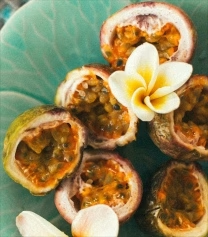Cut open a passion fruit, stir the insides with a spoon, scoop out a spoonful of the orange-yellow juice, and sip. The sweet and sour taste spreads throughout your mouth.
This is the passion fruit we eat. The orange-yellow, translucent, membrane-like structure is not only the flesh, but also the passion fruit’s “aril.” The aril is a membrane-like or fleshy structure covering the seed, attracting food and aiding seed dispersal.
Are passion fruit flowers more eye-catching than the fruit?
Passion fruit has a captivating aroma. The passion fruit flower has a unique appearance. The petals and calyx are arranged like the hands of a clock. The filigree corona, with its purple inner ring and white outer ring, adds to its gorgeous and eye-catching appearance. A closer look at the passion fruit flower reveals that it truly resembles a clock.
Select passion fruit in two steps.
To select passion fruit, start by identifying it based on its appearance. The skin of a ripe passion fruit turns purple-red, though yellow varieties remain yellow when ripe. If the fruit has a darker skin, be especially careful to check for cracks or dents, as these can sour the flavor.
Gently shake the passion fruit. If you feel fluid flowing, the flesh may be separating, releasing juice from the membranes of the aril, resulting in a more sour flavor. Therefore, it’s best to choose fruit with intact flesh.


Leave a Reply